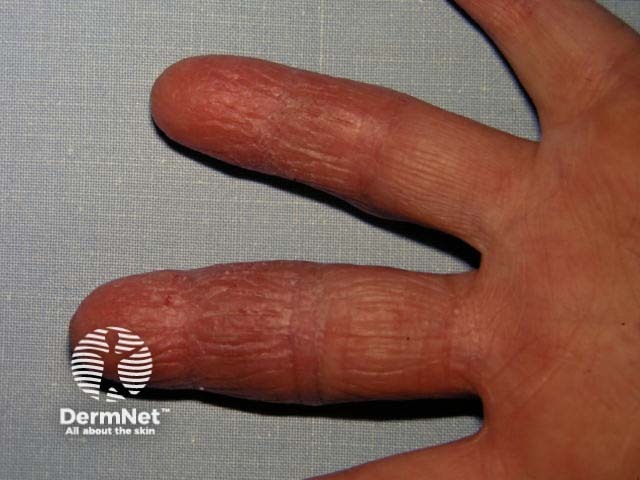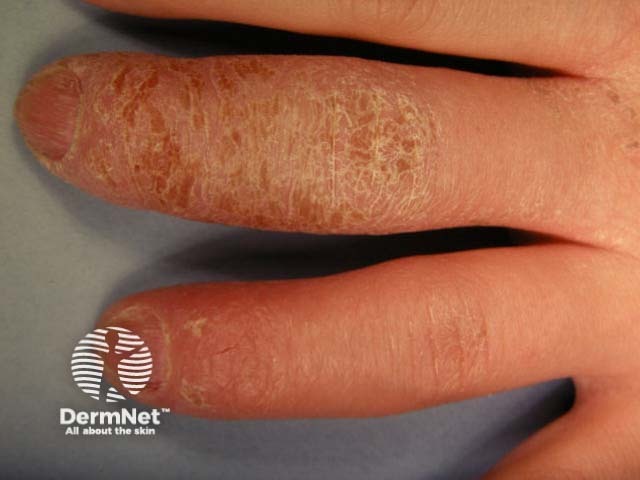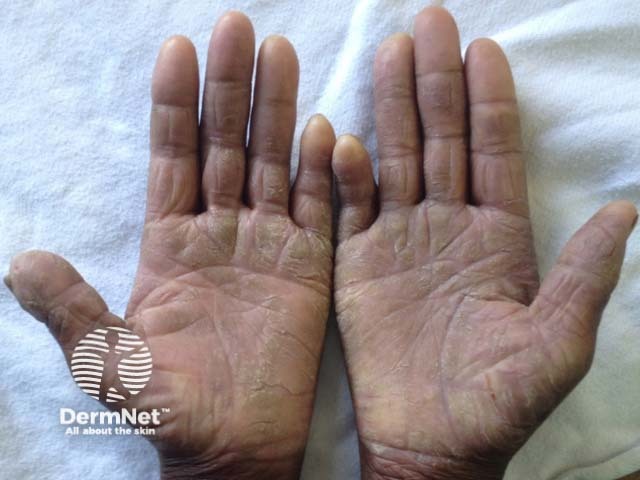Main menu
Common skin conditions

NEWS
Join DermNet PRO
Read more
Quick links
Author: Dr Karen Koch, Consultant Dermatologist, Wits University Donald Gordon Medical Centre, Johannesburg, South Africa. DermNet Editor in Chief: Adjunct A/Prof Amanda Oakley, Dermatologist, Hamilton, New Zealand. Copy edited by Gus Mitchell. April 2019.
Introduction Demographics Causes Clinical features Complications Diagnosis Differential diagnoses Treatment Outcome
Mycosis fungoides palmaris et plantaris is a very rare localised form of mycosis fungoides, a type of cutaneous T-cell lymphoma. While mycosis fungoides affects the hands in about 10% of cases, the palmoplantar variant only affects the hands and feet [1].

Mycosis fungoides palmaris

Mycosis fungoides palmaris

Mycosis fungoides of the palms
There are fewer than 30 reported cases of mycosis fungoides palmaris et plantaris. Although mycosis fungoides palmaris et plantaris can affect all ages, it tends to occur in middle-aged adults [2]. It affects men more frequently than women [2].
The exact cause of mycosis fungoides palmaris et plantaris is not known. No single viral, genetic, epigenetic, or environmental factor has been linked to mycosis fungoides [3].
Mycosis fungoides palmaris et plantaris most often resembles persistent hand eczema and foot eczema [1,2].
However, the clinical features of mycosis fungoides palmaris et plantaris can be widely variable. Blisters and pustules, erosions, tumours, and ulcers have all been reported. It rarely affects the nails [2].
Mycosis fungoides palmaris et plantaris may cause pain, fissuring, and difficulty in using the hands and feet.
The clinician may be alerted to an unusual cause of hand and foot dermatitis by frequent relapses and a resistance to regular treatments. A full skin examination should be undertaken, including evaluation of the lymph nodes, as enlarged lymph nodes could suggest a more widespread lymphoma.
The diagnosis of mycosis fungoides palmaris et plantaris is established by a skin biopsy and assessment by a dermatopathologist.
The histological features of mycosis fungoides can be subtle, as early T-cell lymphoma may resemble eczema. Several repeated biopsies may be necessary.
A blood count is needed to ensure there is no associated Sézary syndrome.
The differential diagnosis for mycosis fungoides palmaris et plantaris includes all forms of hand dermatitis. The following should be considered:
Treatment options for mycosis fungoides palmaris et plantaris depend on the extent of disease, local expertise, and the available drugs and equipment. The following have been used alone or in combination with success:
Mycosis fungoides palmaris et plantaris very rarely spreads to other tissues and is considered to be slow-growing.
Unlike some other lymphomas, the outlook is generally good. Symptoms can usually be controlled with treatment. However, treatment is not curative, and it may recur after a remission lasting many months or years.